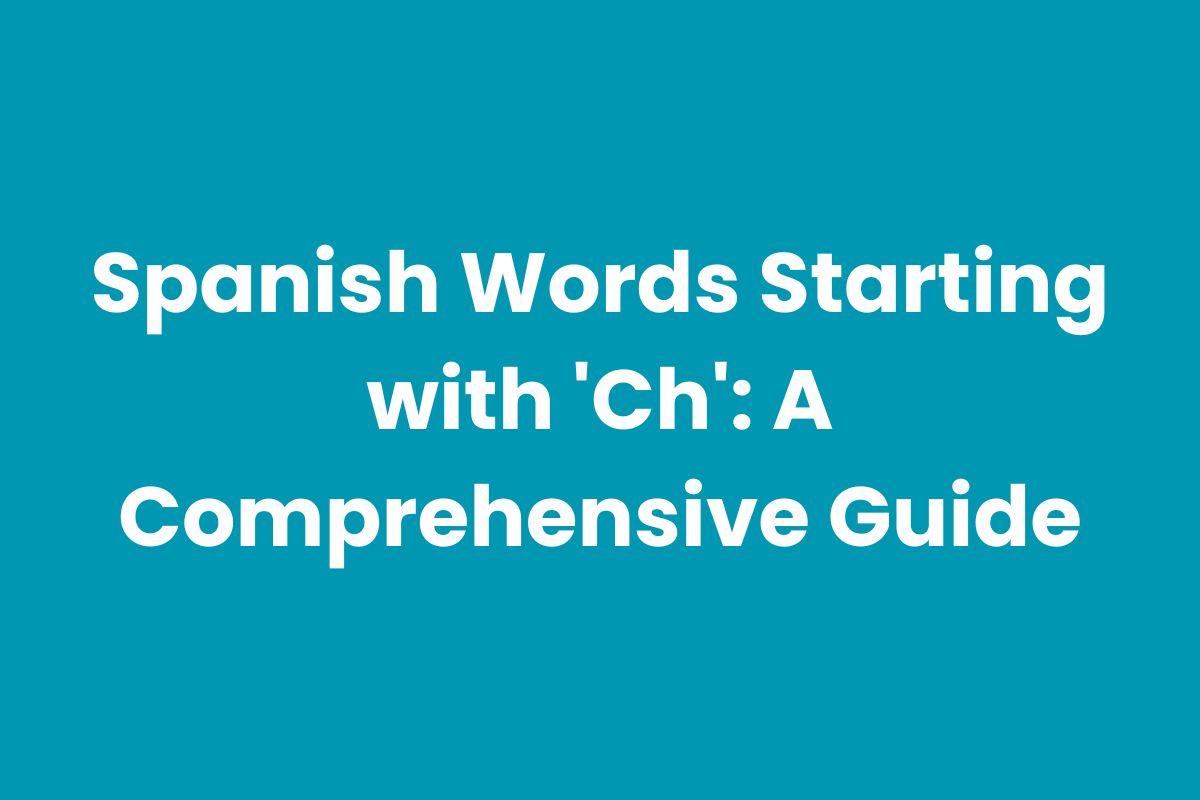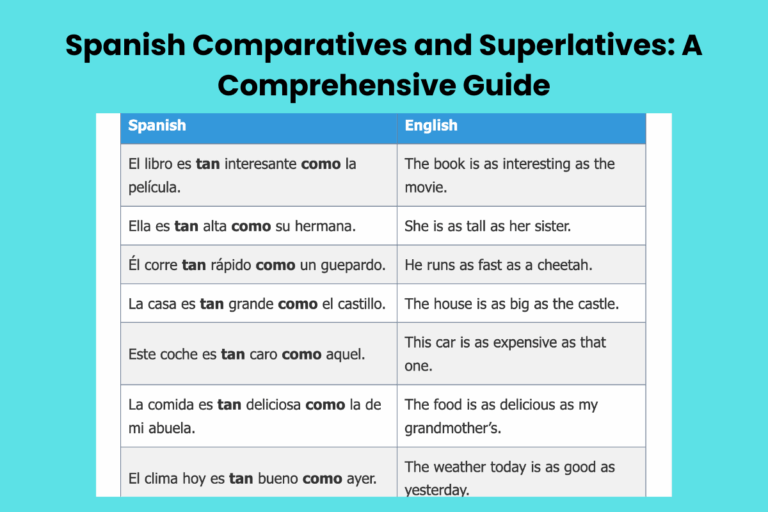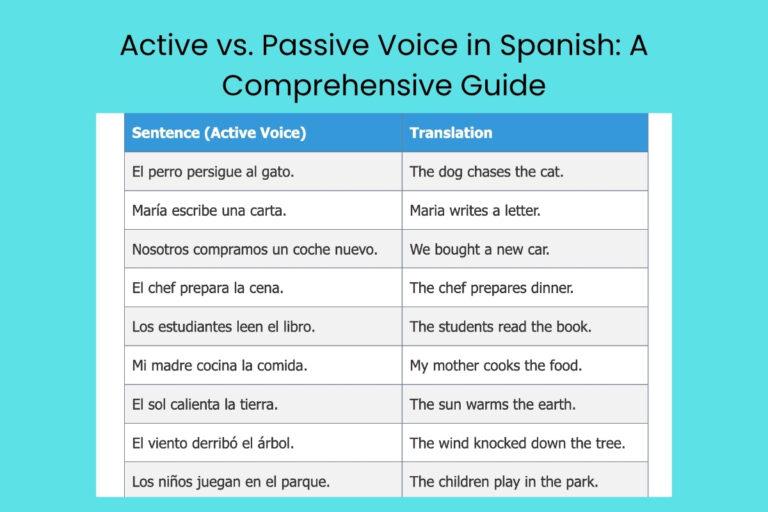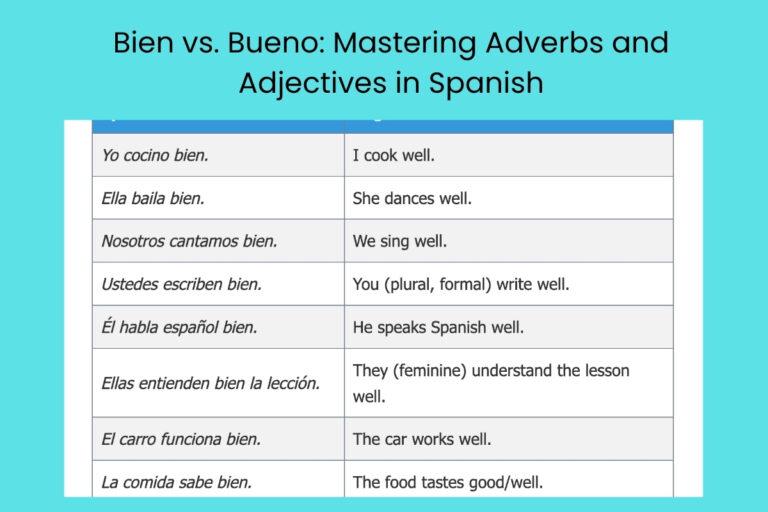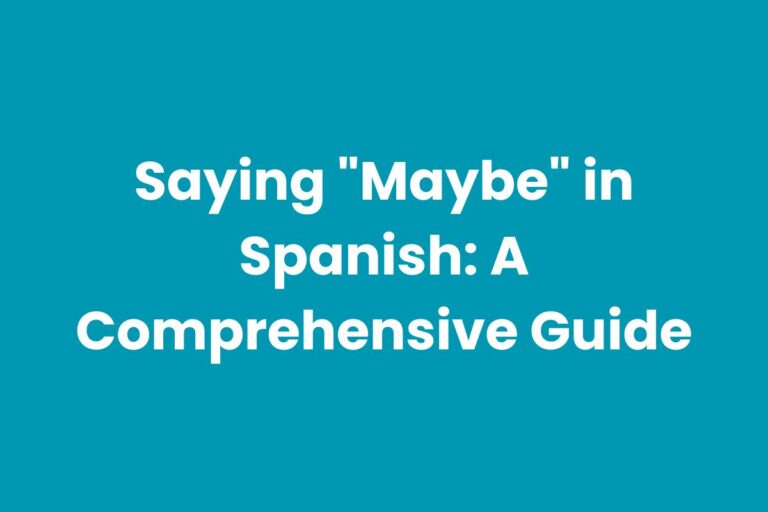Spanish Words Starting with ‘Ch’: A Comprehensive Guide
Understanding Spanish words that begin with the letter combination “ch” is crucial for mastering Spanish pronunciation and expanding vocabulary. Unlike English, where “ch” can produce a variety of sounds, in Spanish, it traditionally represents a single, distinct sound.
This article provides a comprehensive exploration of ‘ch’ words in Spanish, covering their pronunciation, usage, common examples, and potential pitfalls for learners. Whether you’re a beginner or an advanced student, this guide will enhance your understanding and fluency in Spanish by demystifying this important aspect of the language.
Table of Contents
- Introduction
- Definition of ‘Ch’ in Spanish
- Pronunciation of ‘Ch’
- Structural Breakdown
- Types and Categories of ‘Ch’ Words
- Examples of Spanish Words Starting with ‘Ch’
- Usage Rules
- Common Mistakes
- Practice Exercises
- Advanced Topics
- FAQ
- Conclusion
Introduction
The Spanish language, with its rich history and global presence, presents unique phonetic challenges for learners. One such challenge lies in understanding the nuances of the digraph “ch.” In English, “ch” can represent different sounds, as in “chair” or “chord.” However, in Spanish, “ch” traditionally represents a single, consistent sound.
This article aims to provide a comprehensive guide to Spanish words starting with “ch,” clarifying their pronunciation, usage, and grammatical context. Mastering these words is essential for improving pronunciation, expanding vocabulary, and achieving fluency in Spanish.
This guide is designed for Spanish learners of all levels, from beginners grappling with basic pronunciation to advanced students seeking to refine their understanding of the language. By exploring various examples, usage rules, and common mistakes, this article offers a practical and accessible approach to mastering “ch” words in Spanish.
Ultimately, a solid understanding of these words will contribute to improved comprehension, communication, and confidence in using the Spanish language.
Definition of ‘Ch’ in Spanish
In Spanish, the digraph “ch” (che) is a combination of the letters ‘c’ and ‘h’ that traditionally represents a single consonant sound. This sound, known as the voiceless postalveolar affricate, is similar to the “ch” sound in the English word “church.” However, it’s crucial to understand that the Spanish “ch” has a more consistent and predictable pronunciation than its English counterpart. Unlike English, where ‘ch’ can also sound like /k/ (as in ‘chaos’), the Spanish ‘ch’ almost always maintains its distinct affricate sound.
The function of ‘ch’ in Spanish is primarily to represent this specific consonant sound at the beginning, middle, or end of words (although it is less common at the end). It is considered a single letter for the purposes of alphabetization in traditional Spanish dictionaries.
The contexts in which “ch” appears are varied, ranging from common nouns and verbs to adjectives and adverbs. Understanding its definition and function is the first step towards mastering its usage in the Spanish language.
Pronunciation of ‘Ch’
The pronunciation of the Spanish “ch” is a key aspect to master. It is pronounced as a voiceless postalveolar affricate, which involves a combination of a stop and a fricative sound.
To produce this sound, the tongue touches the roof of the mouth slightly behind the alveolar ridge (the area behind your teeth), and air is released with a slight burst of sound.
Here’s a step-by-step guide to pronouncing the Spanish “ch” correctly:
- Start by positioning your tongue as if you were going to say the English “t” sound.
- Move your tongue slightly further back in your mouth, towards the soft palate.
- Press your tongue against the roof of your mouth and briefly stop the airflow.
- Release the air with a slight burst, creating a friction sound as it passes through the narrow opening between your tongue and the roof of your mouth.
- Ensure that the sound is voiceless, meaning that your vocal cords do not vibrate.
It’s important to practice this pronunciation with various words to develop muscle memory and ensure consistent accuracy. Listen to native Spanish speakers and try to imitate their pronunciation of “ch” words.
Pay attention to the subtle differences between the Spanish “ch” and the English “ch” sound, especially if your native language does not have an equivalent sound.
Structural Breakdown
The structural breakdown of Spanish words starting with “ch” involves analyzing the position of “ch” within the word and the letters that follow it. Typically, “ch” appears at the beginning of a word, followed by a vowel or a consonant.
The combination of “ch” with different vowels (a, e, i, o, u) produces distinct syllables that contribute to the overall pronunciation of the word.
Here are some common patterns:
- ch + a: chaqueta (jacket), chocolate (chocolate)
- ch + e: cheque (check), chico (boy)
- ch + i: chile (chili), china (China)
- ch + o: choclo (corn), choza (hut)
- ch + u: chuleta (chop), chupar (to suck)
Understanding these patterns can help learners predict the pronunciation of new words and improve their reading fluency. Additionally, it’s important to recognize that “ch” can also be followed by consonants, such as in the word cháchara (chatter) or chambra (blouse). In these cases, the pronunciation of “ch” remains consistent.
Types and Categories of ‘Ch’ Words
Spanish words starting with “ch” can be categorized into various types based on their grammatical function and meaning. Here are some common categories:
Nouns
Nouns are words that represent people, places, things, or ideas. Many Spanish nouns begin with “ch,” representing a wide range of objects and concepts.
Verbs
Verbs are words that describe actions, occurrences, or states of being. Several Spanish verbs start with “ch,” often related to specific actions or processes.
Adjectives
Adjectives are words that describe or modify nouns. While less common than nouns and verbs, some Spanish adjectives begin with “ch,” adding descriptive qualities to nouns.
Adverbs
Adverbs are words that modify verbs, adjectives, or other adverbs. Adverbs beginning with “ch” are relatively rare in Spanish.
Interjections
Interjections are words or phrases that express sudden emotions or reactions. Some interjections in Spanish may start with “ch.”
Examples of Spanish Words Starting with ‘Ch’
This section provides extensive examples of Spanish words starting with “ch,” categorized by their grammatical function. Each table includes a variety of words to illustrate the diverse usage of “ch” in the Spanish language.
Examples of Nouns Starting with ‘Ch’
The following table showcases examples of Spanish nouns that begin with the digraph ‘ch’. These nouns represent a diverse range of objects, people, and concepts, illustrating the breadth of vocabulary that utilizes the ‘ch’ sound.
| Spanish Noun | English Translation |
|---|---|
| Chaqueta | Jacket |
| Chocolate | Chocolate |
| Cheque | Check (financial) |
| Chico/a | Boy/Girl |
| Chile | Chili pepper |
| China | China |
| Choclo | Corn (South America) |
| Choza | Hut |
| Chuleta | Chop (meat) |
| Churro | Churro |
| Chiste | Joke |
| Chaleco | Vest |
| Champú | Shampoo |
| Charco | Puddle |
| Chatarra | Scrap metal |
| Chef | Chef |
| Chabola | Shack |
| Chantaje | Blackmail |
| Chaparrón | Downpour |
| Chapa | Badge |
| Chancleta | Sandal, flip-flop |
| Chasquido | Snap (of fingers) |
| Chicharra | Cicada |
| Chisme | Gossip |
| Chivo | Goat (male) |
| Chubasco | Shower (rain) |
| Chupete | Pacifier |
| Chusma | Rabble |
Examples of Verbs Starting with ‘Ch’
This table focuses on Spanish verbs that commence with ‘ch’. These verbs encompass a variety of actions and states, providing a glimpse into the active use of ‘ch’ within the Spanish verb lexicon.
| Spanish Verb | English Translation |
|---|---|
| Chocar | To crash, to collide |
| Chupar | To suck |
| Charlar | To chat |
| Chismear | To gossip |
| Chapotear | To splash |
| Chuletear | To crib off (slang) |
| Chantajear | To blackmail |
| Chistar | To utter a word, to murmur |
| Chamuscar | To singe, to scorch |
| Chapar | To catch, to grab |
| Chirlar | To chirp (birds) |
| Chocar (reflexive: chocarse) | To bump into |
| Chulear | To pimp (slang) |
| Chispear | To spark |
| Chivar | To snitch |
| Chanchullar | To botch, to do sloppily |
| Chapear | To kiss (slang) |
| Chantrear | To hustle (slang) |
| Chafardear | To snoop around |
| Chisgarabitear | To scribble |
| Chicotear | To whip |
| Chorizar | To steal (slang) |
| Chumarse | To get drunk (slang) |
| Chuzar | To prick, to stab |
Examples of Adjectives Starting with ‘Ch’
The following table contains Spanish adjectives that begin with the digraph ‘ch’. These adjectives provide descriptive qualities that can be used to modify nouns, adding depth and detail to descriptions.
| Spanish Adjective | English Translation |
|---|---|
| Chiquito/a | Small, tiny |
| Chocante | Shocking |
| Chulo/a | Cute, cool (Spain) |
| Chafado/a | Crushed, flattened |
| Charrúa | Charruan (relating to an indigenous group) |
| Chiflado/a | Crazy, mad |
| Chillón/chillona | Shrill, loud |
| Chistoso/a | Funny, witty |
| Chocho/a | Delighted, thrilled |
Examples of Adverbs Starting with ‘Ch’
This table includes the few instances of Spanish adverbs that begin with the digraph ‘ch’. Due to the rarity of adverbs starting with ‘ch’, the list is intentionally concise, highlighting those adverbs that do exist.
| Spanish Adverb | English Translation |
|---|---|
| Chas! | Snap! (sound of fingers snapping) |
Examples of Interjections Starting with ‘Ch’
The table below showcases Spanish interjections that begin with the digraph ‘ch’. Interjections are often used to express sudden feelings or reactions, and these examples illustrate how ‘ch’ can be used to convey such emotions in Spanish.
| Spanish Interjection | English Translation |
|---|---|
| ¡Chist! | Shush! |
| ¡Chao! | Goodbye! (informal) |
| ¡Che! | Hey! (Argentina, Uruguay) |
Usage Rules
The usage of “ch” in Spanish is governed by a few key rules. First and foremost, it is crucial to remember that “ch” is treated as a single letter in Spanish, both in pronunciation and alphabetization.
This means that when looking up words in a traditional Spanish dictionary, words starting with “ch” are listed after words starting with “c” but before words starting with “d.”
Another important rule is that the pronunciation of “ch” remains consistent regardless of the vowel or consonant that follows it. This consistency simplifies pronunciation for learners, as there are no variations in the “ch” sound based on the surrounding letters.
However, it is worth noting that in some regions, particularly in certain parts of Latin America, the traditional “ch” sound is becoming less common, and some speakers may pronounce it as a /ʃ/ sound (similar to the “sh” in “ship”). While this pronunciation is not considered standard, it is important to be aware of it, especially when interacting with speakers from these regions.
Common Mistakes
One of the most common mistakes made by English speakers learning Spanish is mispronouncing “ch” by applying English pronunciation rules. For example, pronouncing chocolate with a /k/ sound instead of the correct /tʃ/ sound. Another common mistake is confusing words that start with “ch” with similar-sounding words that start with “c” or “s.”
Here are some examples of common mistakes and their corrections:
| Incorrect | Correct | Explanation |
|---|---|---|
| Kocolate (pronouncing “chocolate” with a /k/ sound) | Chocolate (pronouncing “chocolate” with a /tʃ/ sound) | The “ch” in Spanish is pronounced as /tʃ/, not /k/. |
| Casa (using “casa” instead of “choza” for “hut”) | Choza (using “choza” for “hut”) | “Casa” means “house,” while “choza” specifically means “hut.” |
| Sico (misspelling “chico”) | Chico (correct spelling of “boy”) | “Chico” starts with “ch,” not “s.” |
To avoid these mistakes, it is crucial to practice pronunciation regularly and pay close attention to the spelling of words. Use flashcards, language learning apps, and other resources to reinforce your knowledge and identify areas where you need more practice.
Practice Exercises
These practice exercises are designed to help you reinforce your understanding of Spanish words starting with “ch.” Each exercise focuses on a different aspect of “ch” usage, from pronunciation to vocabulary recognition.
Exercise 1: Pronunciation
Pronounce the following words aloud, paying attention to the correct “ch” sound.
| Word | Pronunciation (IPA) |
|---|---|
| Chaqueta | /tʃaˈketa/ |
| Cheque | /ˈtʃeke/ |
| Chile | /ˈtʃile/ |
| Choclo | /ˈtʃoklo/ |
| Chuleta | /tʃuˈleta/ |
| Chico | /ˈtʃiko/ |
| China | /ˈtʃina/ |
| Choza | /ˈtʃoθa/ or /ˈtʃosa/ (depending on region) |
| Chupar | /tʃuˈpaɾ/ |
| Charlar | /tʃaɾˈlaɾ/ |
Exercise 2: Vocabulary Recognition
Match the Spanish word with its English translation.
| Spanish Word | English Translation | Answer |
|---|---|---|
| 1. Chaqueta | a) Corn | 1. b |
| 2. Cheque | b) Jacket | 2. c |
| 3. Chile | c) Check (financial) | 3. d |
| 4. Choclo | d) Chili pepper | 4. a |
| 5. Chuleta | e) To suck | 5. f |
| 6. Chupar | f) Chop (meat) | 6. e |
Exercise 3: Fill in the Blanks
Complete the following sentences with the correct Spanish word starting with “ch.”
- Me gusta comer ________ con leche. (I like to eat ________ with milk.)
- Necesito un ________ para pagar la cuenta. (I need a ________ to pay the bill.)
- El ________ es muy picante. (The ________ is very spicy.)
- Vamos a ________ en el parque. (We are going to ________ in the park.)
- El ________ es mi hijo. (The ________ is my son.)
Answers:
- chocolate
- cheque
- chile
- charlar
- chico
Exercise 4: Translation
Translate the following sentences into Spanish, using words starting with “ch.”
- The boy is eating chocolate.
- I need to cash a check.
- She is wearing a jacket.
- Let’s chat for a while.
- The hut is small.
Answers:
- El chico está comiendo chocolate.
- Necesito cobrar un cheque.
- Ella está usando una chaqueta.
- Vamos a charlar un rato.
- La choza es pequeña.
Exercise 5: Error Correction
Identify and correct the errors in the following sentences.
| Incorrect Sentence | Correct Sentence |
|---|---|
| 1. Yo como kocolate. | 1. Yo como chocolate. |
| 2. Necesito un seque. | 2. Necesito un cheque. |
| 3. El sico es alto. | 3. El chico es alto. |
| 4. La kasa es pequeña. | 4. La choza es pequeña. (if referring to a hut) |
| 5. Vamos a sarlar. | 5. Vamos a charlar. |
Advanced Topics
For advanced learners, there are several more complex aspects of “ch” usage in Spanish to explore. One such topic is the regional variations in pronunciation, particularly the tendency in some Latin American countries to pronounce “ch” as /ʃ/.
Understanding these variations is crucial for effective communication with speakers from different regions.
Another advanced topic is the etymology of “ch” words in Spanish. Many “ch” words have origins in indigenous languages, such as Nahuatl (the language of the Aztecs) and Quechua (the language of the Incas).
Exploring the etymology of these words can provide valuable insights into the history and culture of the Spanish-speaking world.
Additionally, advanced learners can delve into the use of “ch” in idiomatic expressions and colloquial language. Many Spanish idioms and slang terms contain “ch” words, and understanding these expressions is essential for achieving a high level of fluency.
FAQ
- Is the ‘ch’ in Spanish always pronounced the same?
Yes, traditionally, the ‘ch’ in Spanish is pronounced as a voiceless postalveolar affricate (/tʃ/), similar to the ‘ch’ in the English word “church.” However, there are regional variations where some speakers, particularly in parts of Latin America, may pronounce it closer to /ʃ/ (like the “sh” in “ship”). While this is not considered standard, it is important to be aware of it.
- How is ‘ch’ alphabetized in Spanish dictionaries?
In traditional Spanish dictionaries, ‘ch’ is treated as a single letter. Therefore, words starting with ‘ch’ are listed after words starting with ‘c’ but before words starting with ‘d’. However, newer dictionaries may alphabetize words phonetically, which means ‘ch’ words might be listed under ‘c’ based on their pronunciation.
- Are there any Spanish words that end with ‘ch’?
Words ending in ‘ch’ are very rare in standard Spanish. The digraph ‘ch’ is much more commonly found at the beginning or in the middle of words. If you encounter a word ending in ‘ch’, it is likely a loanword from another language or a regional variation.
- Why do some people pronounce ‘ch’ differently in different Spanish-speaking countries?
Language is dynamic and varies across different regions. The pronunciation of ‘ch’ as /ʃ/ in some parts of Latin America is a result of linguistic evolution and regional dialects. These variations are influenced by historical factors, contact with other languages, and the natural development of speech patterns within specific communities.
- How can I improve my pronunciation of the Spanish ‘ch’?
To improve your pronunciation of the Spanish ‘ch’, practice regularly by listening to native speakers and imitating their pronunciation. Focus on positioning your tongue correctly and producing the voiceless postalveolar affricate sound. Use language learning apps, online resources, and pronunciation guides to reinforce your learning. Recording yourself and comparing your pronunciation to that of native speakers can also be very helpful.
- Are there any English words that I can use as a reference to pronounce the Spanish ‘ch’?
Yes, the ‘ch’ sound in the English word “church” is a good reference point for the Spanish ‘ch’. However, it’s important to ensure that you are producing a clear and crisp sound, as the Spanish ‘ch’ tends to be more distinct than its English counterpart. Pay attention to the placement of your tongue and the release of air to achieve the correct pronunciation.
- What are some common mistakes to avoid when using ‘ch’ in Spanish?
Common mistakes include mispronouncing ‘ch’ as /k/ (as in “chaos” in English), confusing words that start with ‘ch’ with similar-sounding words that start with ‘c’ or ‘s’, and not recognizing the regional variations in pronunciation. To avoid these mistakes, practice pronunciation regularly, pay close attention to spelling, and be aware of regional differences.
- How does the ‘ch’ sound in Spanish compare to other similar sounds in other languages?
The Spanish ‘ch’ sound is similar to the ‘tch’ sound in some French words or the ‘cz’ sound in Polish. However, it’s crucial to listen to native Spanish speakers to accurately mimic the sound, as subtle differences exist. The key is to focus on the precise tongue placement and the voiceless affricate nature of the sound.
- Is it important to know the origin of Spanish words starting with ‘ch’?
While not strictly necessary for basic communication, knowing the etymology (origin) of words can enrich your understanding of the Spanish language and culture. Many Spanish words starting with ‘ch’ have indigenous roots, reflecting the influence of native languages on the Spanish lexicon. This knowledge can provide insights into the history and cultural context of these words.
- How can I practice using Spanish words starting with ‘ch’ in real conversations?
To practice using Spanish words starting with ‘ch’ in real conversations, try incorporating them into your daily interactions. Engage in conversations with native Spanish speakers, either in person or online. Use language exchange apps or websites to find conversation partners. Focus on using the new words you’ve learned in context, and don’t be afraid to make mistakes – they are a natural part of the learning process. You can also create flashcards and review them regularly to reinforce your vocabulary.
Conclusion
Mastering Spanish words starting with the digraph “ch” is essential for achieving fluency and accuracy in the language. This comprehensive guide has provided a detailed exploration of the pronunciation, usage, and grammatical context of “ch” words, equipping learners with the knowledge and tools necessary to confidently incorporate them into their vocabulary.
By understanding the consistent pronunciation of “ch,” recognizing common mistakes, and practicing regularly, learners can significantly improve their Spanish language skills.
Remember to pay attention to regional variations in pronunciation and to explore the etymology of “ch” words to gain a deeper understanding of the Spanish language and culture. Continue to practice using “ch” words in real conversations and to seek out opportunities to interact with native Spanish speakers.
With dedication and perseverance, you can master the nuances of “ch” words and achieve your goals in learning Spanish.

